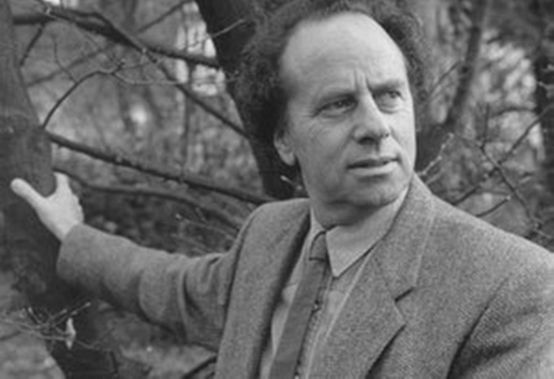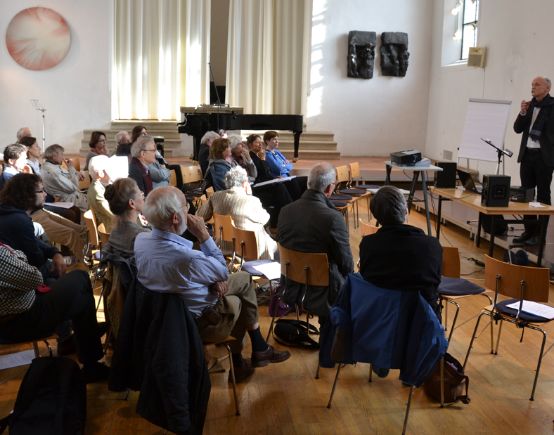Farewell, oleander and fig tree
On November 21, the Künstlerhaus Boswil held a symposium to mark the 20th anniversary of the death of the Hungarian-Swiss composer János Tamás.

What was particularly exciting about this event was the mixture of theoretical and practical lectures, with musicologists alternating with musicians who are very familiar with the work of János Tamás (1936-1995). In this way, the composer and the man who emigrated to Switzerland in 1956 because of the Hungarian uprising and was placed in a foster family were illuminated in a multifaceted way.
At the age of 20, János Tamás fled alone from the dictatorial terror in his home country. Although he later started a family here and made a living as a piano teacher at the Alte Kantonsschule Aarau, as well as conducting at the Theater Biel-Solothurn, the Aargauer Oper and the Orchesterverein Aarau, he received little recognition as a composer on the Swiss music scene.
The fact that the Paul Sacher Foundation, which also helped organize the symposium, took over Tamás' estate four years ago is a late but all the more valuable gesture. Heidy Zimmermann, who is in charge of the foundation's "Hungarian collection", gave an insight into the Sacher Foundation's collecting activities. Tamás is seen here as a complement to the prominent Hungarians, including Béla Bartók, Sándor Veress, György Ligeti and György Kurtág.
In her presentation, Tamás' biographer Verena Naegele highlighted the difficulties of the "eternal emigrant" in a differentiated manner. The young, promising composer and pianist, who had begun studying music with Ferenc Farkas in Budapest, found contact with a fellow countryman in Switzerland: he studied with Sándor Veress in Bern. However, the balancing act between his Hungarian musical roots and the democratically free but artistically uninspiring life in Aarau remained painful for him and even led to the composer's inner isolation.
Modern in a playful way
Musicologist Anna Dalos from the Liszt Academy of Music in Budapest traveled all the way from Budapest for the Tamás Symposium. She spoke about the Hungarian music scene after 1956, which is little known in our part of the world. The twelve-tone and serial writing styles were hardly received there, as they were not permitted by the communist regime. The tonal constraints remained strong, and a rather naive idea of 20th century compositional techniques prevailed. Only György Kurtág practiced the row technique after 1968, and István Lang (1933) was, according to Anna Dalos, the most important pioneer with glissandi, noises, aleatoric free spaces and the detachment from metrical feeling.
Whether the pieces performed at the symposium or the orchestral works presented on CD: Tamás' music impressed and got under the skin. It is sparsely scored, poetically atmospheric, dramaturgically interesting and very modern in a playful way. The pianist Tomas Dratva probably knows the piano works best; he also premiered the piano concerto posthumously and has recorded several pieces by Tamás on CD. Together with the flautist Eva Oertle and the violist Alexander Besa, he played two typical pieces: Music in the twilight (1979) and the Sonata for viola and piano (1957/1974), which Tamás had revised during his studies with Veress. In a lecture-recital, Dratva also gave an insight into the trio Fire pictures (1986), which he subsequently performed with the clarinettist Fabio Di Cásola and the violist Alexander Besa (Oehms classic OC 443).
Music journalist Thomas Meyer reported on what it was like in Sándor Veress's composition class. Important Swiss composers such as Heinz Holliger, Roland Moser and Jürg Wyttenbach studied with Veress, János Tamás was the only Hungarian. Veress did not speak much as a teacher and only taught composition on a one-to-one basis. As a result, his students hardly knew each other and each was able to develop their own original musical language.
Aargau colleagues
Aargau was not simply frustrating for Tamás. It enabled him to make a living as a musician and teacher, as Verena Naegele explained in her presentation. Here he found interesting fellow teachers such as Jean-Jacques Dünki, Thomas Baldinger and Tomas Dratva, who performed and still perform his pieces. Tamás dedicated his first piano sonata to the pianist and "touch artist" Dünki. Dünki played the rather virtuoso work at the symposium and gave interesting explanations, for example that the composer's detailed and differentiated playing instructions can also restrict performers. Dünki also accompanied the songs The face of a bird (1984) on poems by the Aargau poet Erika Burkart, which Kurt Widmer once premiered and now also performed sensitively at the symposium.
Michael Schneider, who runs the Künstlerhaus Boswil, was a student of Tamás. In his presentation on the Ballad for orchestra (1989) points to interesting associations with the composer, whose symphonic "sound play" refers to Shostakovich's Symphony No. 5 and Bartók's Divertimento for Strings. Music professor Peter Laki, who is related to Tamás and lives in Cleveland, has often published on Tamás' music. Now he spoke about the religious backgrounds and contexts in the Jewish composer's oratorios.
The libretto to the oratorio Noah's daughter (1985) was written by the Aargau writer Claudia Storz. She told how highly inspired the collaboration with Tamás was. The sentence from her libretto "Ade, du Oleander und Feigenbaum. We say goodbye now. Life was so good" was quoted by both artists as they said goodbye to each other. It symbolizes the final farewell to life, which Tamás took with his own hand on November 14, 1995.
Further information
Book: Verena Naegele, Martin Matter and others: Fire pictures - shadow sounds. János Tamás - composer, pianist, pedagogue, Musikverlag Müller & Schade, Bern 1997
-

Thomas Meyer spoke about the composition class of Sándor Veress. Photo: Künstlerhaus Boswil








